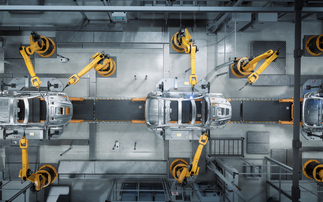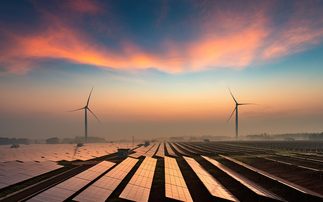
Executive Summary
The world is undergoing a remarkable transformation right now, greatly accelerated by the energy transition, coupled with an urgent need for energy security. In our view, these diverse drivers of change can be summarized into the "3Ds" of infrastructure, fundamental themes related to decarbonization, digitalization and decentralization, that we see as crucial over the decades ahead.
This note explores the infrastructure investment implications of decarbonization and the way ahead, intended to help investors navigate the new landscape, drive change with investment capital, and innovate with new solutions to meet complex, evolving challenges.
- Navigating the carbon transition
We believe Infrastructure sits at the heart of the energy transition and energy security needs in Europe and globally, in our view opening up a window of investment opportunities ahead, not just in adding renewable power capacity, but also in decarbonizing all sectors, including the transportation, manufacturing and agriculture sectors. The transformation of the way the world makes and uses energy, moves goods and people and constructs the built environment will reshape the real economy and we expect infrastructure to play a central role in accelerating the transition to a more-sustainable, low-carbon economy. We believe the transition to a low-carbon global economy is going to create the greatest investment opportunity of our lifetime. Indeed, the International Energy Agency (IEA) estimates a need of US$125 trillion of new investment in the next three decades.[1]
However, the transition will not happen overnight. While renewables are expected to continue to grow and become the leading source of energy in the global supply mix by 2050, we cannot just simply turn off the switch on fossil fuels as we need to maintain current infrastructure for reliability. The global energy transition will be a long, multi-decade journey that will require companies to progressively pass through shades of brown to shades of green. For the foreseeable future, we see hydrocarbon and renewable companies working side by side to ensure the continuity of supply and affordable energy prices. Existing infrastructure will still need to be upgraded and repurposed as we move along the transition. It will take considerable time and capital to retool the hydrocarbon industries that provide essential services.
- Driving change with capital
As the world moves towards net zero with increasing urgency, we see considerable scope for investors to drive the transition with their investment capital. In our view, there are several distinct components to this investment push. First, the one thing we are certain about is that renewable power generation will play a critical role in all net zero scenarios, allowing investors to capitalize in the transition by investing in zero-carbon investments that directly lead to an avoidance of emissions. While there is good progress already, with renewables accounting for 38% of electricity supply in 2021 - surpassing the contribution from coal - more investment is still needed, with growth of 20% per annum needed by 2030 to align with the 1.5°C goal set by the Paris Climate Agreement.[2]
Further, we believe investors can gain exposure to the transition not only through "already-green" assets, but also through assets of hydrocarbon companies with a credible transition plan. A portfolio that only gets exposure to the transition through low-carbon sectors and companies could miss important investment opportunities. For example, we see natural gas playing an important role as a transition fuel to support both industries and consumers. It is a vital energy source that society needs for reliability, given its portability. We believe that replacing coal with a combination of renewables and natural gas can potentially yield the quickest carbon reduction at scale. In addition, blue hydrogen and ammonia are also critical. According to the IEA, over 60% of the hydrogen network may be repurposed from natural gas infrastructure 2. This means that the energy companies of today can drive the build out of tomorrow's sustainable infrastructure network. As investors, we need to manage conventional infrastructure assets well to ensure they continue to provide critical services today, while positioning these assets for a green transition tomorrow.
- Finding innovative solutions
Reaching net zero by 2050 requires the wider adoption of available technologies as well as the rapid development of new technologies that are not quite ready in the market yet. In this context, we see many ways ahead to accelerate the global energy transition and drive innovation forward, by investing in new climate technology, especially for hard-to-abate sectors, which are parts of the economy that cannot easily be decarbonized. Looking ahead, we see the biggest opportunities for innovation potentially coming from advanced batteries, charging technologies, hydrogen electrolysers and carbon capture and storage.
Advanced batteries. Battery technology is improving quickly as companies compete to deliver longer-lasting, faster-charging products, especially for electric vehicles. Better battery performance remains a key factor - alongside charging networks - impacting the take-up of electric cars and even electric airplanes. In the future we see most cars running on electricity or fuel cells and planes relying on advanced biofuels and synthetic fuels.
Charging ahead. The accelerated rollout of charging networks is removing the last major impediment for widespread adoption of electric cars, ahead of the proposed phase-outs of internal combustion engines across more countries in the 2030s. Meanwhile, the electrification of commercial trucks is rapidly gaining momentum, requiring refits in transport hubs and logistics centers.
Hydrogen electrolysers. Hydrogen will likely be a critical part of the equation to decarbonize hard-to-abate sectors. While global hydrogen production for energy purposes is currently small, the outlook is changing rapidly with new policy support and incentives. A key pillar of Europe's REPower EU strategy is targeting 10Mt of domestic clean hydrogen production and 10Mt of imported clean hydrogen by 2030. With added policy support and rapid adoption, we anticipate a significant reduction in the production costs of clean hydrogen, similar to what we saw initially for wind and solar, and more recently for batteries. In our view, green hydrogen may reach cost parity with grey hydrogen by mid-decade, and parity with diesel fuel for long-haul transport by the decade's end.
Carbon capture and storage. Facilities that can extract and store carbon at an industrial scale are leaving the realms of science fiction and landing in the real world. Already, ethanol pipelines are set to be tapped for liquefied carbon for extraction and underground storage. Carbon Capture and Sequestration is potentially an efficient, cost-effective solution to reduce emissions in heavy industries. Newer technologies like Direct Air Carbon Capture and Storage, the pilot technology that recoups carbon from the air, could unlock an immensely scalable method to remove atmospheric carbon, irrespective of the initial source. With 7.2GT of sequestration needed annually by 2050, carbon capture capacity will likely need to increase 100 times by 2050.
Source: BlackRock, September 2022. IEA, Carbonomics. There is no guarantee that any forecasts and forward-looking expectations made will come to pass.
Implications
For infrastructure investors, there is a massive amount of investment opportunity ahead to navigate the transition towards net zero, drive the energy transition and push for innovative technical and financial solutions. Given that the infrastructure that supports the economy today is the result of decades of deployed capital, the investment decisions investors make today will be critical to build a greener, cleaner future. The path to net zero is not easy and requires a diverse set of initiatives and sustained infrastructure investments.
In our view, the transition presents opportunities for investment in different points of the journey:
- Invest in low carbon infrastructure that directly avoids greenhouse gas emissions to sustain the rapid expansion of renewable power capacity to meet ambitious national targets.
- Repurpose existing infrastructure to cut emissions, partnering with hydrocarbon companies to help them transition from shades of brown to shades of green.
- Invest in new climate technology, particularly for harder-to-abate sectors, that could accelerate the low carbon transition and disrupt current business models.
Investors want and need help navigating an ever more complex world in the search for income, inflation mitigation and diversification, often, with an overarching goal to support the goal of net zero greenhouse gas emissions by 2050. In our view, adding infrastructure to a portfolio can help investors achieve all these goals and potentially build stronger, more resilient portfolios.
Explore alternative investment strategies at BlackRock
[1] Source: BlackRock, September 2022. IEA, February 2022, Carbonomics, Goldman Sachs, June 2021. All figures are in US dollars.
[2] Source: BlackRock, September 2022. General Electric Company, "Accelerated Growth of Renewables and Gas Power Can Rapidly Change the Trajectory on Climate Change" (2020).
Disclaimers
Risk Warnings
Capital at risk. The value of investments and the income from them can fall as well as rise and are not guaranteed. Investors may not get back the amount originally invested.
Past performance is not a reliable indicator of current or future results and should not be the sole factor of consideration when selecting a product or strategy.
Changes in the rates of exchange between currencies may cause the value of investments to diminish or increase. Fluctuation may be particularly marked in the case of a higher volatility fund and the value of an investment may fall suddenly and substantially. Levels and basis of taxation may change from time to time.
Important Information
This material is for distribution to Professional Clients (as defined by the Financial Conduct Authority or MiFID Rules) only and should not be relied upon by any other persons.
In the UK and Non-European Economic Area (EEA) countries: this is issued by BlackRock Investment Management (UK) Limited, authorised and regulated by the Financial Conduct Authority. Registered office: 12 Throgmorton Avenue, London, EC2N 2DL. Tel: + 44 (0)20 7743 3000. Registered in England and Wales No. 02020394. For your protection telephone calls are usually recorded. Please refer to the Financial Conduct Authority website for a list of authorised activities conducted by BlackRock.
Any research in this document has been procured and may have been acted on by BlackRock for its own purpose. The results of such research are being made available only incidentally. The views expressed do not constitute investment or any other advice and are subject to change. They do not necessarily reflect the views of any company in the BlackRock Group or any part thereof and no assurances are made as to their accuracy.
This document is for information purposes only and does not constitute an offer or invitation to anyone to invest in any BlackRock funds and has not been prepared in connection with any such offer.
© 2022 BlackRock, Inc. All Rights reserved. BLACKROCK, BLACKROCK SOLUTIONS, and iSHARES are trademarks of BlackRock, Inc. or its subsidiaries in the United States and elsewhere. All other trademarks are those of their respective owners.
MKTGH1122E/S-2574140-5/5








